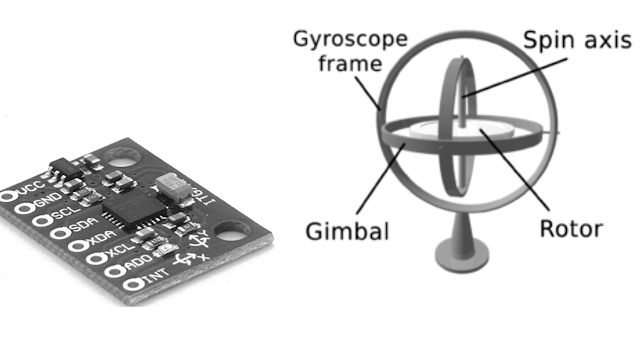Gyroscope sensor How It Works and applications
Gyroscope sensor
What is a gyroscope?
Definition :
A gyroscope is a device for measuring or maintaining orientation, based on the principles of conservation of angular momentum.
Properties of gyroscopes
Gyroscopes have two basic properties: Rigidity and Precession These properties are defined as follows:
Rigidity: The axis of rotation (spin axis) of the gyro wheel tends to remain in a fixed direction in space if no force is applied to it.
Precession: The axis of rotation has a tendency to turn at a right angle to the direction of an applied force
Types of Gyroscopes available
Spinning Mass Gyro
Mass spins steadily within the gyro with free movables axis (gimbals).
Optical Gyroscope
Laser rays reflect many times within an enclosure, any changes in orientation will be registered as changes between the moment of the laser emittance to eventual reception.
Vibrating Gyroscope
Determines rate of turn by a vibrating resonator and its change in vibrations from the original vibrating direction.
Gas Rate Gyro
Sprays gas on heated coils, when a change in direction occurs the spray is curved resulting in a change in the temperature of the coils. (Currently unpractical because of the numerous factors involved
Mechanical Gyroscope
A mechanical gyroscope is essentially a spinning wheel or disk whose axle is free to take any orientation. This orientation changes much less in response to a given external torque than it would without the large angular momentum associated with the gyroscope's high rate of spin.
Applications of Gyroscopes
A. In Aeronautics and Aviation
- Remote control flying devices, helicopters, some hovercraft, some planes, etc. rely on gyroscopes to prevent them from flipping over or going into a spin.
- Spacecraft rely on gyroscopes for orientation while in space.
- Aircraft and aircraft autopilots rely on gyroscopes to account for changes in direction & altitude
B. In Naval field
- Gyroscope are used in ships to maintain stability as the effect of gyroscopic couple is on
- Steering
- Pitching
- Rolling
C. In automobiles
- Gyroscopic behaviour is used in the racing car industry. This is because car engines act just like big gyroscopes. Because of the of the gyroscopic forces from the engine depending on whether the engine is spinning clockwise or anti-clockwise the cars nose will be forced up or down.
- Wheels on motorbikes act as gyroscopes and make the bike easier to balance (stay up right) when moving.
D. In toys and everyday uses
- Gyroscopes are used in various toys such as yo-yos and Frisbees. Some other toy products are Gravitron and ChikyuGoma.
E. In electronics and gadgets
- Gyroscopes are used in various fields nowadays such as in smartphones, video game controllers, computer mouses and presentation mouses.

Comments
Post a Comment